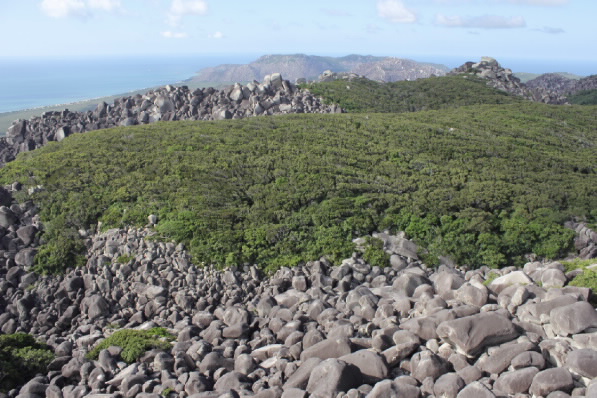Media Releases
More species discovered in Australia's 'Lost World'
More new species discovered in Australia's lost World.
October 30th, 2014

Cape Melville rainforest in Cape York
A James Cook University researcher has discovered another two new species of lizard, hidden from humans for millions of years in a remote area of Cape York Peninsula, in far north Queensland.
JCU’s Dr Conrad Hoskin found the Cape Melville Rainbow Skink and Cape Melville Bar-lipped Skink on an expedition to the rainforest plateau on top of the Cape Melville Range, 170 km north of Cooktown.
Dr Hoskin said the two species were hidden in the isolated range, a virtual mountaintop fortress cut off from the surrounding area by piles of huge granite boulders.
The lizards have been officially named and described in the latest edition of the international journal Zootaxa, taking the tally of new animals discovered during Dr Hoskin’s Cape Melville trips to a remarkable five.
The expeditions to the plateau last year also found three other unique species: a leaf-tailed gecko, a boulder frog, and a golden lizard, which prompted international headlines describing Australia as host to a ‘lost world’ of animals isolated by a freak of geography.
Dr Hoskin said that’s not unfounded. “I think it’s justified. The Melville Range has been sitting there completely isolated from other rainforest areas for millions of years. It’s truly remarkable. It probably has more unique animal species per unit area than anywhere else in Australia.”
He said there may well be other discoveries to come. “We are looking in detail at another lizard that could also be new. And the invertebrate and plant collections made during the surveys are still being assessed by experts.
“This is on top of three vertebrate species that were discovered there in past decades. So that’s eight animal species that are found only at Cape Melville, making their entire world distribution about the size of inner Sydney.”
The scientific names of the two new lizards - Carlia wundalthini and Glaphyromorphus othelarrni - were chosen by Traditional Owners of the Cape Melville region in collaboration with Dr Hoskin. Both names refer to Traditional Owners who once lived in the Cape Melville area.
The Cape Melville surveys were funded by the National Environmental Research Program (NERP), National Geographic, and the Australian Biological Resources Study.
Contact details:
Dr Conrad Hoskin: conrad.hoskin@jcu.edu.au Work: +61 (7) 4781 6048 / Mobile: 0435 026 840
Alistair Bone, JCU Media Liaison, alistair.bone@jcu.edu.au 07 4781 4942 / Mobile 0409 734 542
Photos of the two new lizards and of Cape Melville can be downloaded from:
https://www.dropbox.com/sh/6u60b1jdhxp98ym/AAA8tEHMvCSFzK8kmiPDCWhma?dl=0
All photo credits must read: Conrad Hoskin
The Zootaxa description papers for the new species can be downloaded from:
https://www.dropbox.com/sh/2e0o4ubfm1e55ds/AABjEMY-aWsHZwA76WauoNBva?dl=0